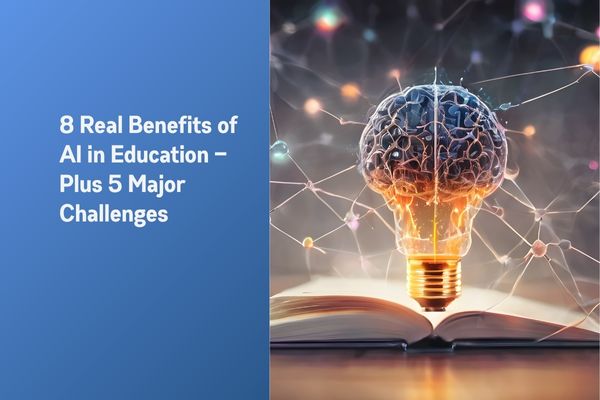
8 Real Benefits Of AI In Education — Plus 5 Major Challenges
Classrooms in 2025 look different. Students use smart tools, teachers get digital help, and learning feels closer to each student. The benefits of AI in education show up in quick feedback, study plans made for one student, and grading that cuts teacher load.
The benefits of AI in education are real and wide. Still, some problems come with these gains: students may rely on tools too much, teachers may lose a personal touch, and schools must choose what stays human and what turns automatic.
Read this article to see how AI is changing higher education right now, the practical wins, and the hard questions colleges must solve.
8 Real Benefits Of AI In Education — Plus 5 Major Challenges
8 Ways AI in Higher Education Can Improve Learning Outcomes
1. Tailored Study Paths for Each Student
2. Fast Feedback on Assignments
3. After-class Help that Works on Your Time
4. Real-world Simulations and Labs without Risk
5. Spotting Who Needs Help Early
7. Language Support for International Students
8. Better Research and Project Guidance
5 Challenges of Using AI in Education You Must Know
1. Data Privacy and Student Security
2. Too Much Dependence on Tools
3. Unequal Access Creates an AI Gap
4. Wrong Answers and Made-up Facts
What is AI in Education?
When we hear AI in education, it means machines, software, or apps that help in learning, teaching, or schooling tasks. It’s not a robot replacing your teacher. Instead, it’s a tool that helps your teacher be better or helps you learn smarter.
For example, an app that checks your spelling, a program that tracks which math steps you struggle with, or a system that suggests which chapter you should study next. In higher education, this means colleges are using these tools to support students and staff.
According to a 2025 survey, approximately 86% of faculty members expect to use AI in teaching in the future. That shows how big this is becoming.
The goal is to have more personal help, less one-size-fits-all. However, that means we also must stick to safe use, good data rules, and teacher-student bonds.
If you want to see exactly how AI is boosting learning in colleges, check out this article: 9 Essential Ways AI in Higher Education Can Improve Learning Outcomes
8 Ways AI in Higher Education Can Improve Learning Outcomes
Now that you know what is meant by AI in education, let’s get into the practical side. Here are ten real ways colleges and universities are using it to make learning easier, smarter, and more personal for students.

1. Tailored Study Paths for Each Student
Imagine you’re studying biology. Rather than everyone doing the same worksheet, the system notices you struggle with the mitochondria concept. So it gives you extra examples and a simpler video until you get it. Then you move to the next part.
That’s the idea of personalised study paths – thanks to the benefits of artificial intelligence in education. In higher education, each student can get a path that matches their pace and style. This reduces stress and wasted time on what you already know.
When tools work like this, students feel more confident and engaged.
2. Fast Feedback on Assignments
You hand in a draft essay. A few hours later, you get comments like, “Good idea here, but you missed an example here.” Yes, that’s AI at work.
According to a Gallup-Walton Family Foundation 2024 report, teachers using AI tools save on average about 5.9 hours per week, which over a school year adds roughly six weeks.
That time saved means teachers can give more real-talk feedback or meet you one-on-one.
For you as a student, faster feedback helps you fix mistakes while the topic is fresh.
3. After-class Help that Works on Your Time
When your teacher is off campus or busy grading, help doesn’t have to stop. AI tutoring tools are available all day, ready to explain topics again or quiz you till you master them. They’re like extra tutors that never get tired or frustrated.
For college students, this kind of access can make a big difference, especially when learning complex subjects like statistics or chemistry.
Some platforms adjust their tone and examples, too, based on your progress. So, it means lesser “I’ll do it later” moments and steadier learning throughout the semester.
4. Real-world Simulations and Labs without Risk
Some lessons need practice, not only reading. But in fields like nursing, aviation, or mechanical engineering, mistakes can be costly or dangerous.
That’s where AI-powered simulations come in. They allow students to test real-life scenarios safely, such as diagnosing a virtual patient or fixing a jet engine system. The best part is that you can repeat until you get it right, and the simulation gives clear steps on what to try next.
This makes the leap from theory to real skill much easier. Students gain hands-on experience and confidence before they face real equipment or real people.
5. Spotting Who Needs Help Early
Every teacher wants to notice when a student is struggling, but with hundreds of students, it’s tough. AI helps by quietly watching data like attendance, quiz results, and online activity.
If a student starts missing assignments or scoring lower than usual, the system alerts the teacher. That early nudge can save a student before they completely lose track.
Predictive models help staff offer support such as tutoring, counselling, or deadline help right when they matter. That’s the real advantage of AI in education for students, it turns small problems into fixable ones before they become big ones.
Want to see how AI is transforming one-on-one support beyond classrooms? Check out this related read — AI Agents for Coaching Are the Future
6. Smarter Grading Systems
Grading hundreds of papers or quizzes is no easy job – to be honest. AI tools help teachers check assignments faster and more accurately, especially for subjects like English or social sciences.
They highlight grammar mistakes, check for plagiarism, and also suggest where arguments can be stronger. For teachers, this means less time marking and more time mentoring. For students, it means results come faster, with more detailed feedback.
The benefits of AI in higher education go beyond speed; they create a fairer grading system, where every student’s work gets equal attention without human bias.
7. Language Support for International Students
Universities attract students from all around the world. But for many, English, or the main teaching language, isn’t their first language. AI tools like language translators and smart note-takers make learning easier.
They convert lectures into multiple languages or give real-time subtitles, helping students follow along without stress. Some even correct grammar while writing essays, improving both confidence and clarity.
This kind of support makes sure everyone, no matter where they’re from, can focus on learning, not simply trying to understand words. It’s one of the powerful advantages of AI in education for students studying abroad.
8. Better Research and Project Guidance
College projects and theses can be overwhelming. Finding reliable sources, summarizing long research papers, or structuring a report can take hours.
AI research assistants simplify all that. They quickly gather credible references, detect gaps in your arguments, and suggest improvements. Tools like Elicit or Research Rabbit even help visualize connections between studies, saving time and boosting understanding.
Instead of replacing the hard work, they guide you to do it more efficiently. It’s like you have a research companion who is great at going through academic journals, so you can focus on the thinking part.
5 Challenges of Using AI in Education You Must Know
While AI brings plenty of good, it’s not all sunshine and perfect grades. Like every new technology, it comes with its own set of challenges, mainly in the world of education.
Let's look at some of these challenges.

1. Data Privacy and Student Security
When students use AI tools, a lot of personal data is collected, from grades to study habits. If that data isn’t protected, it could be exposed or misused.
That worries both students and universities. According to a UNESCO survey, less than 10% of schools and universities had formal guidance on AI use, which means many institutions still lack clear rules on data and privacy.
Students should know who can see their data and how it’s used. AI should help learning, not put privacy at risk.
2. Too Much Dependence on Tools
AI can make homework faster, but if students lean on it all the time, they may stop practicing thinking on their own. Learning is practice. When someone always gets an answer handed to them, their problem-solving muscle gets weak.
Teachers worry that easy AI answers will replace the small struggles that help the brain grow. So, schools must teach how to use AI like a calculator, helpful for some steps, but not a way to skip learning.
Good rules say – use AI to check ideas, not to do your thinking for you. That keeps learning honest and makes sure students gain skills that stick for life.
3. Unequal Access Creates an AI Gap
Not every student has a fast laptop or steady internet. If a course assumes everyone will use paid AI tools or cloud platforms, some learners get left out. This gap grows unfairly, richer students get extra help, while others fall behind.
Solutions include loaner laptops, campus Wi-Fi hotspots, and free tool access for all students. Universities should plan with equity in mind; pick tools that work on old phones, offer offline versions, or give campus credits for premium services.
Equal access turns AI from a privilege into a real classroom helper for everyone.
4. Wrong Answers and Made-up Facts
Sometimes AI gives confident answers that are wrong. This is called a hallucination. If students copy these answers without checking, they learn mistakes.
That causes confusion and harms trust. Teachers must teach checks, always confirm facts using trusted books or class notes, and treat AI answers as a draft, not the truth.
Make assignments that require personal reflection, local examples, or in-class steps that AI cannot fake. That forces students to think and proves they really know the material.
5. Fear and the Need for Teacher Training
Many teachers worry that AI will take their place, but it won’t; it just changes how teaching looks. The real challenge is learning how to use it well.
With the right training, teachers can use AI to handle boring admin work and spend more time guiding students. Colleges should offer workshops and peer sessions to make educators comfortable using these tools.
As George Couros said, “Technology will never replace great teachers, but technology in the hands of great teachers can be transformational.”
Final Word from Purely Startup
AI is here to make learning more human – not to replace teachers. It gives time back to educators, helps students learn their way, and turns classrooms into spaces where everyone can keep up, not simply the top few.
Still, no tool can replace a teacher’s smile, a good explanation, or the spark that happens when someone gets it. That’s where real education lives.
The benefits of AI in education are shaping how we learn in 2025, but the balance between technology and humanity is what truly matters.
If you’re a student, teacher, or part of a college team, now’s the time to explore AI tools. Try one step, track how it helps, and adjust as you go. The future classroom isn’t far; it’s already here, and you get to shape it.


